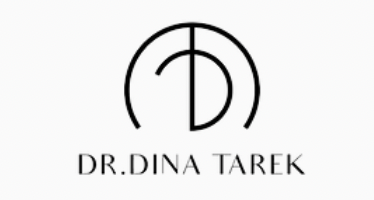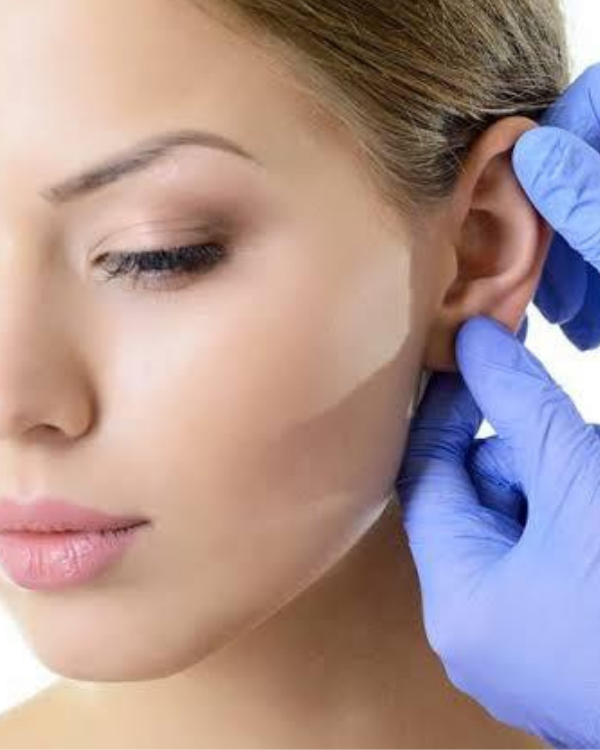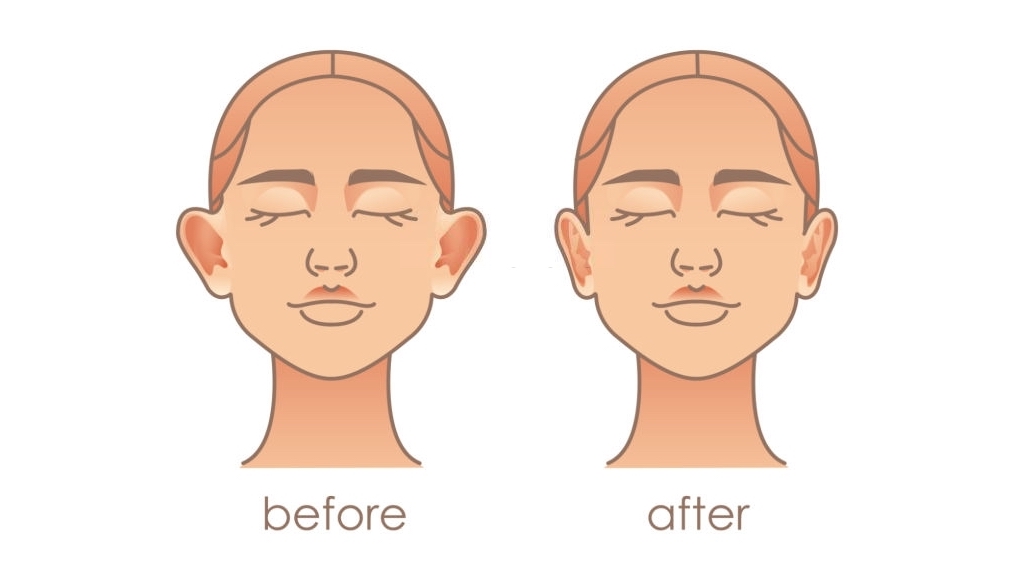
FACE PROCEDURES
Otoplasty
Having prominent ears can make you self-conscious and affect your confidence. Many people often feel that their ears are too large and an unfolded ear cartilage can make your ear stick out. Sometimes it’s the ear lobes themselves – they can be oversized and quite floppy. These problems are all readily resolved with sculpturing and buried stitches. Otoplasty Ear Surgery – Ear Correction or Ear Pinning – can help both adults and children.



Plastic Surgery for Damaged or Ripped Ear lobes – If you have a split your ear lobe or have stretched your ear piercing this can be corrected by a complex local skin flap using special plastic surgical techniques. Otoplasty, commonly known as prominent ear surgery or cosmetic ear surgery, is one of the most common procedures in cosmetic and corrective surgery. Ear deformity in terms of its separation from the head is the most common inherited anomaly among numerous deformities on the outer part of the ear.
Prominent or asymmetrical ears are difficult to hide and represent an aesthetic problem that can become a source of deep dissatisfaction in children, teenagers, but also adults. Otoplasty is mostly performed during childhood, but people of all ages can undergo this surgical procedure. The growth and development of the auricle end around the 5th year of life, after which it is possible to surgically correct the auricle. The goal of the operation is to decrease the ears’ prominence, get the natural shape of the ear, and to remove the psychological burden of the patient.
Ear surgery or otoplasty is an aesthetic procedure that:
- corrects the shape of the ear
- changes the size of the ear
- changes the position of the ear
- changes the proportion of the ears
Otoplasty can be done when the ears reach their full size, most often after the age of 5. This operation is recommended if the eardrums are placed so that they protrude significantly outside the surface of the head, if the eardrums are larger than the size of the head and if you are dissatisfied with the result of the previous operation.
You might be a good candidate for Otoplasty if:
- You have lower self-esteem due to prominent ears
- You experienced emotional stress and taunting due to the appearance of your ears
- You are at least 5 years old
- You are in good overall health
Ears are typically not the major focal point of one’s face, but if they visibly protrude it can leave some people feeling self-conscious or unhappy about their looks.
An ear correction and beautification intervention will help you not only to change the look of your ears but also your overall appearance, which will definitely affect your self-confidence. And that self-confidence has no price is something that all satisfied patients who have done this operation a long time ago now.
You can expect:
- Proportional and contoured outer ear.
- Permanent results
- An increase in self-confidence
- A feeling of satisfaction and relief for solving this aesthetic problem that has always bothered you.
Recovery from Otoplasty ear pinning surgery is typically very quick, and most patients will not require more than 10. Days off work unless they are experiencing discomfort or pain.
After the surgery, your ears will be covered with protective bandages to protect the incision area. You will wear the bandage for 24-48 hours. This bandage will be replaced with an elastic band to protect your ears from traumas for the next 5-7 days.
Dissolvable stitches are often used when suitable, and these then dissolve within 7-10 days. Three to four weeks after surgery, an elastic band is worn at night to prevent unintentional ear injuries during sleep.
During the first couple of days of recovery, you might experience some swelling, bruising, itching, and mild discomfort. Iwill provide you with painkillers which usually help the most patient to manage pain easily.
I will receive detailed post-operative instructions from your doctor, which should be followed in order to achieve optimal results, speed up recovery, and avoid complications.
Normally, just a couple of hours after the surgery you will be discharged from the hospital. Demanding physical activities and contact sports should be avoided at least for a month.
Most patients go back to their regular activities (school, work) in a week after the surgery.
In the six weeks following your operation, it’s a good idea to wear a protective headband at night, to prevent the ear from folding over during sleep. The same applies to children playing or adult sports.
FACE PROCEDURES
Otoplasty
Having prominent ears can make you self-conscious and affect your confidence. Many people often feel that their ears are too large and an unfolded ear cartilage can make your ear stick out. Sometimes it’s the ear lobes themselves – they can be oversized and quite floppy. These problems are all readily resolved with sculpturing and buried stitches. Otoplasty Ear Surgery – Ear Correction or Ear Pinning – can help both adults and children.
The Facial Surgery procedure helps to lift and firm sagging facial tissues to restore a more naturally youthful facial appearance. It is often said that having a facelift works to ‘turn back the clock’, helping you to look more like a younger version of yourself.





Otoplasty
About The Procedure
Plastic Surgery for Damaged or Ripped Ear lobes – If you have a split your ear lobe or have stretched your ear piercing this can be corrected by a complex local skin flap using special plastic surgical techniques. Otoplasty, commonly known as prominent ear surgery or cosmetic ear surgery, is one of the most common procedures in cosmetic and corrective surgery. Ear deformity in terms of its separation from the head is the most common inherited anomaly among numerous deformities on the outer part of the ear.
Prominent or asymmetrical ears are difficult to hide and represent an aesthetic problem that can become a source of deep dissatisfaction in children, teenagers, but also adults. Otoplasty is mostly performed during childhood, but people of all ages can undergo this surgical procedure. The growth and development of the auricle end around the 5th year of life, after which it is possible to surgically correct the auricle. The goal of the operation is to decrease the ears’ prominence, get the natural shape of the ear, and to remove the psychological burden of the patient.
Ear surgery or otoplasty is an aesthetic procedure that:
- corrects the shape of the ear
- changes the size of the ear
- changes the position of the ear
- changes the proportion of the ears



Otoplasty
Am I a good candidate for Otoplasty?
Otoplasty can be done when the ears reach their full size, most often after the age of 5. This operation is recommended if the eardrums are placed so that they protrude significantly outside the surface of the head, if the eardrums are larger than the size of the head and if you are dissatisfied with the result of the previous operation.
You might be a good candidate for Otoplasty if:
- You have lower self-esteem due to prominent ears
- You experienced emotional stress and taunting due to the appearance of your ears
- You are at least 5 years old
- You are in good overall health
Otoplasty
Benefits of Otoplasty
Ears are typically not the major focal point of one’s face, but if they visibly protrude it can leave some people feeling self-conscious or unhappy about their looks.
An ear correction and beautification intervention will help you not only to change the look of your ears but also your overall appearance, which will definitely affect your self-confidence. And that self-confidence has no price is something that all satisfied patients who have done this operation a long time ago now.
You can expect:
- Proportional and contoured outer ear.
- Permanent results
- An increase in self-confidence
- A feeling of satisfaction and relief for solving this aesthetic problem that has always bothered you.
Otoplasty
Recovery & Results: What to Expect
Recovery from Otoplasty ear pinning surgery is typically very quick, and most patients will not require more than 10. Days off work unless they are experiencing discomfort or pain.
After the surgery, your ears will be covered with protective bandages to protect the incision area. You will wear the bandage for 24-48 hours. This bandage will be replaced with an elastic band to protect your ears from traumas for the next 5-7 days.
Dissolvable stitches are often used when suitable, and these then dissolve within 7-10 days. Three to four weeks after surgery, an elastic band is worn at night to prevent unintentional ear injuries during sleep.
During the first couple of days of recovery, you might experience some swelling, bruising, itching, and mild discomfort. Iwill provide you with painkillers which usually help the most patient to manage pain easily.
I will receive detailed post-operative instructions from your doctor, which should be followed in order to achieve optimal results, speed up recovery, and avoid complications.
Normally, just a couple of hours after the surgery you will be discharged from the hospital. Demanding physical activities and contact sports should be avoided at least for a month.
Most patients go back to their regular activities (school, work) in a week after the surgery.
In the six weeks following your operation, it’s a good idea to wear a protective headband at night, to prevent the ear from folding over during sleep. The same applies to children playing or adult sports.
2021© All rights reserved by Dr.Dina Tarek
